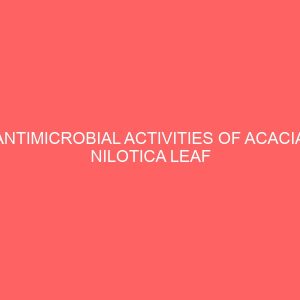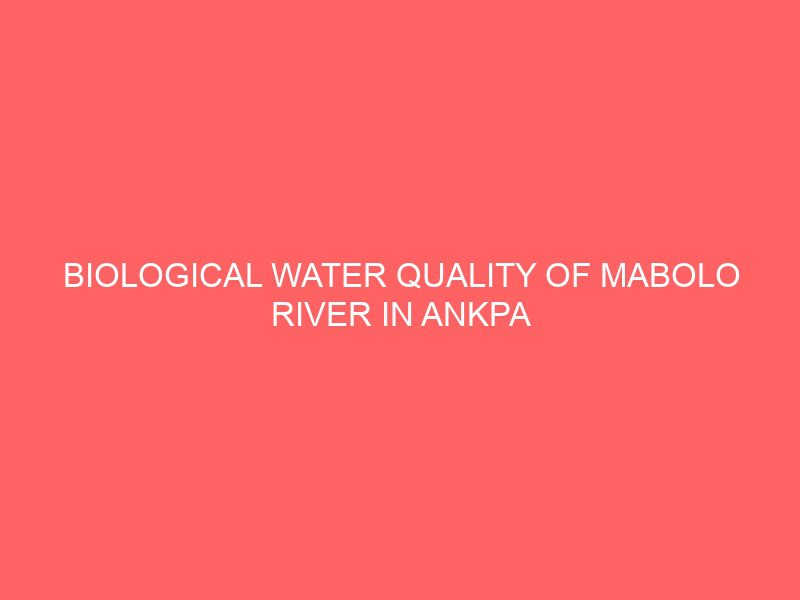Description
CHAPTER ONE
1.0 INTRODUCTION
This research is on Biological water quality of mabolo river in Ankpa Kogi state Nigeria. The river Mabolo transects over five districts located in south earthen of Kogi including Okura Ubele, Ofu, Ankpa, and Otukpo watershed. This river is the major source of the main economic activities in district and most of these activities take place within the river itself and others take place within the catchments such activities include water abstraction, sewage treatment, cattle rearing, agriculture and agro-forestry and many other practices. These activities are all done without the notification of downstream user and as a result the river has deteriorated both in quantity and quality including drying up of wetland around, fringing the river (Mukwaya and Mugabe, 2010). Beside this factors the river Mabolo catchments experience
The total nutrient discharged into surface waters in a river basin is normally larger than the nutrient load at the river mouth (Wassman and olli, 2004); and such discrepancy is a explained by the process of nutrient retention which is a collectives expression for a large number of biochemical and hydrological process of a large temporarily decrease, decay, degrade, transform or permanently retard and removes the substance from the river channel. The significance of streams as nutrient recipients from terrestrial catchments to receiving water bodies is of environmental concern as it may lead to excessive nutrient loading and inability of the system to cope with the loading (Peterson, et, al, 2001).
Ankpa lakes and rivers like other water bodies face a threat of pollution due to increasing human population, urbanization, industrialization and agricultural modernization (Joensuu 1996). There are concerned efforts by government to reduce water pollution and there include the establishment of the Direct ovate of water development under ministry of water and environment which is the principle agency of government and the provision of water supplies in rural and urban centers. The mandate of National sewage corporation (NWSC) is to operate and provide water and sewage services in area entrusted to it by the water Act (1995) and the NWSC Act, cap 150, national Environment offices, National resources management personnel, among others government also formulated polices and regulation to guide national use of water resources in order to achieved sustainable water quality and quantity. Such policies and regulation include the water statute (1995) which provide the frame work for the use protection and management of water resources and water supply, the national water policy (1999) the water resources regulations, (1998) and the waste water discharge Regulations (1998) which prescribe the threshold and procedures for applications to construct any water works. However there are still many challenges including lack of human capacity, inadequate facilitation and inter-institutional co-ordination in order to handle the associated environmental problems.
The Mabolo River has its source right within Ankpa town at a place called Ogaji, climate in the local government. Like other urban rivers and streams its faces similar threats of population and understanding its water quality dynamics as an urban river is an important aspect. Nutrient uptake and transformation is a central ecosystem function of streams (Payne, et, al., 2005), and although many studies may have been done on the water quality of river Mabolo by various researchers, more needs to be known about its water quality of river Mabolo dynamics or variations in terms bacterial load and chemical contamination.
It is notice that the water resources in the river Mabolo have decline over 12 years. This can be attributed to increased degradation of the resources (this has been observed, but it is not measured) due to increase agricultural in the catchments, using poor land and soil management systems, in addition it is noticeable that there has been a declining trend of the catchments rainfall and such phenomena are believed to be the impact of climate change and global warming.
There has been growing concern about the need to protect the environment from the various form of population caused by growing human populations, used of modern agricultural methods etc. (Hunt and Wilson 1986). Micro organisms often play a major role in determining the extent of this pollution (Higgins and Burns 1975) and municipal waste water is a primary contributor of bacteria to the aquatic environment (Linton et al. 1974). The presence of faecal coli-form is considered as presumptive evidence of faecal pollution (Mara, 1978) pathogenic bacteria that have been transmitted by water or waste water include, vibriocholarae, salmonella, leptospira, campylobacter and Yesinia (APHA; 1992).
1.1 STATEMENT OF PROBLEM
Urban river, streams and wetland are prone to pollution (natumanga et al; 2009) and decoration of water quality reduce a river’s amenity and aesthetic value. Like any urban water body, river Mabolo is a source of water for domestic, marketing and agricultural activities within its catch mere (Ankpa municipality inclusive). Due to economic activities in the area such as market, hospital, schools, and industrial setups the water quantity of river Mabolo could be compromised. Not only is this a dilemma for the welfare of the riparian communities using the river for their domestic and economic needs, it is a problem for other aquatic resource as well.
Therefore he propose study seeks to assess the quality status of the river basing on the levels, of the pathogenic micro organisms (E. coli and faecal coli-forms) and aquatic micro invertebrates as indicators for water quality in addition to the physic- chemical parameters within that sector of the municipality.
1.2 RESEARCH QESTIONS.
- What are the responses of others biotic communities (e.g. aquatic macro invertebrates) to the aquatic environment which may be compromised by anthropogenic activities?
- how is the status of the abiotic environmental factors (physico chemical parameters in relation to the ecosystem services they offer to other aquatic resource that are in turn utilized by human to satisfy their needs?
- Worldwide water borne diseases are a major cause of morbidity and mortality in human (WHO, 1996), and water borne pathogens infect around 250 million people per year resulting in 10-20 million deaths to what extent is the river Mabolo by pathogenic microorganisms considering that some people fetch and use this water directly for different domestic purpose?
1.3 JUSTIFICATION
Pollution of water bodies by the ever increasing human activities (agricultural, discharge and domestic waste waters, solid waste disposal run offs etc.) is a serious problem (Chapman 1996), worldwide water born diseases are a major causes of morbidity and mortality in human (WHO 1996), and water born pathogen infect around 250 million people per year resulting in 10-20 million deaths (Annon, 1996)), River Mabolo within Ankpa municipality is not an exception to this threat because of the many activities that are carry out with in and around it catchment. These studies will therefore asses the faecal indication (Escherichia coli and faecal coli forms) and the status of aquatic macro invertebrates as indicators of water quality in relation to the physico chemical parameters.
1.4 LITERATURE REVIEW
Sea level in the up lands Agbaja plateau, which range from 335 to 366 meters above sea level, and the much higher Okoro Agbo hills in Ijumu L.G.A are some of the predominant to land forms of the state, the state is drained by the Niger and Benue rivers which could be view and from the top of mount Patti is located within the state of the Benue river is navigable as far as Garua in the rainy sea son floods, but up to Makurdi in Benue state in the dry season the Mabolo (Anambra) is the biggest river in Igala land Mabolo Okura, Ubele and Ofu rivers run off the Dekina, Onkpo, Otukpa, water shed. Osomera falls at kilometer four on Okene, Ajaokuta Road, of Ofejiji falls in Okura Olafia and Egeneja warmed spring in based local government area are other drainage features (Benue State 1985). Together with breakage of the dysenteric chromatic results in genetically unbalanced gametes, which at fertilization are lethal to the zygotes development consequently, no recombinant progeny resulting from such aberration survive exception recombinant progeny (Hart well et al 200) this observation lends substance to the abstract.








Reviews
There are no reviews yet.